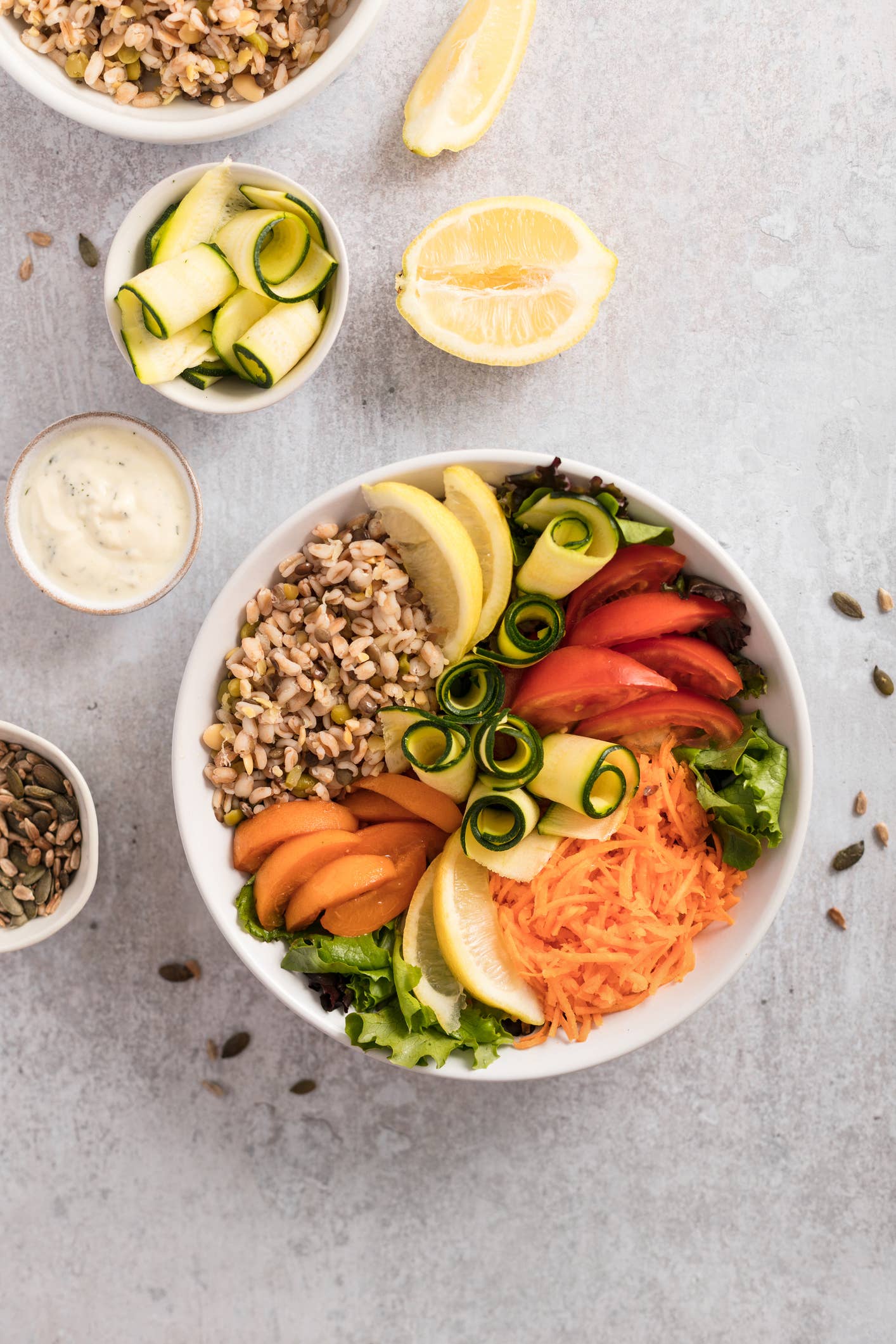
Exactly Which Carbs Lead to Weight Gain? A Nutritionist Explains
A new study has found that fast carbs – or high-glycemic foods – do not make you gain weight more than eating slow carbs – or low-glycemic foods. However, fast carbs such as white bread, pasta, and soda can still cause inflammation and lead to conditions such as heart disease. So if you're aiming to reduce your risk of disease and early mortality as well as lose weight, you might still want to avoid fast-digesting carbs.
Confused? You have a right to be – since for years studies have warned us that white bread, white rice, pasta, sugary drinks – and other "fast carbs" raise blood sugar levels quickly and can lead to weight gain. But the latest evidence is not as clear-cut. Studies are rarely conclusive and looking at headlines about the latest study can provide a limited view of the scientific evidence. Researchers usually note the limitations of their findings in the study, and we should look at these carefully, to put the latest data into context and help us make decisions about what to eat for our health.
Health advice that applies to one person may not apply to their best friend or even their sister, because we all have different genetics, metabolism, and lifestyles. Unfortunately, this means that figuring out what to eat or what are the "best" foods for weight loss can be a minefield of false leads. After looking at the study details, this article hopes to shed some light on key takeaways that people can put into practice if losing weight and staying healthy is the goal.
'Fast carbs' are no worse than 'slow carbs' for weight loss, study finds
The newest study published in Advances in Nutrition has been making the news recently because it dispelled the common myth that fast carbs make you fat. For years, experts have told us to eat low-glycemic (GI) foods to avoid weight gain and keep our bodies healthy.
What is the Glycemic Index? A rating system for foods containing carbohydrates that indicates how quickly a food affects blood sugar (glucose) level when eaten on its own.
We have learned to avoid high GI foods since the sugar in foods with a high GI absorbs faster into the bloodstream and spikes our glucose levels. If we don't burn this extra energy off through exercise, the body stores it as fat. Additionally, high-GI foods can play havoc with the body's ability to regulate insulin in people with diabetes. It can also make us "insulin resistant" by requiring ever-higher levels of insulin to be released to prompt the body to deliver energy to the cells, leading to weight gain.
However, in this new study, scientists found that there is scant evidence that low-GI diets are superior to high-GI diets when it comes to losing weight and the prevention of obesity. The researchers analyzed data from high-quality research comparing low-GI and high-GI diets for weight loss in more than 1.9 million adults. There was no consistent difference in the body mass index (BMI) of those eating high or low-GI foods, and some studies showed that BMI was actually lower in those eating the highest GI foods.
Furthermore, the authors found that low-GI diets were not better than high-GI diets for reducing body weight or body fat. A notable exception was that a low-GI diet with a difference of at least 20 GI units resulted in greater weight loss in people with normal glucose tolerance, but not in those with impaired glucose tolerance (meaning those who have pre-diabetes).
The authors concluded that GI rating is not an accurate measure of how food affects our blood sugar levels, and suggested that low-GI diets are not better for weight loss than high-GI diets.
However, there are some limitations to this study that could influence the results and some important points that we must consider when choosing which carbs to eat.
Glycemic Index values don't reflect how we really eat
One problem with this study that the authors highlighted themselves, is that Glycemic Index values don't reflect real-life meals. Scientists determined the Glycemic Index (GI) values of foods by having young healthy people eating them one by one in tightly controlled laboratory conditions, and assessing how their blood sugar rises. Typically, they would only use small sample sizes to get their data.
However, this doesn't bear in mind the average person eating a combination of foods on a plate and the effect of fiber, macronutrients, preparation, and time of day when eaten - these all determine how our bodies react to the sugar in food.
Grain variety, processing, and cooking affect GI
The University of Sydney's GI database is a well-recognized source of GI values, but it has 27 values for white and brown rice ranging from 17 to 94.
The variation in GI values is determined by the type of rice, how it's processed and cooked, and what you eat it with. This applies to other grains and carbs too.
White, refined carbs or 'fast carbs' have higher GI values because they lack the fiber that helps slow the release of sugars into the blood. Manufacturers remove parts of the grains and polish them into finer textures with longer shelf lives - for example, white rice and white bread, but this means that they can spike our blood glucose. Additionally, other fast carbs such as processed foods and sugary sodas have added sugar which compounds the problem.
Conversely, complex carbohydrates or 'slow carbs' such as whole grains contain the whole kernel – the bran, germ, and endosperm – and are rich in fiber, vitamins, and minerals. Slow carbs release their sugars into the bloodstream more slowly, regulating energy and avoiding blood sugar spikes which can lead to weight gain.
Furthermore, cooking carbohydrate foods makes them easier to digest and quicker to release their sugars, compared to eating a raw salad, where the natural sugars release at a steady pace.
Many studies on how GI affects weight use food questionnaires that participants fill in themselves, but if someone reports they had 'rice' for dinner, the GI of their meal could vary drastically depending on what kind of rice, how it was cooked, and what they ate with it.
The authors of the study noted that the GI of meals may be overestimated by 12 to 19 GI units and the difference between 'high' and 'low' GI foods is on average 10 units. Therefore, meals that the studies considered to be high- GI could actually be low-GI, and the results could be skewed. With the unreliability of self-reporting questionnaires and the variation between GI values for common foods, the results of observational studies into GI, weight loss, and obesity need to be interpreted with caution.
So what should you eat? Stick with slow carbs for health and less belly fat
Looking beyond the new study, the evidence says that people should still choose their carbohydrates carefully, favor slow carbs (low GI foods) and avoid fast carbs (high GI foods) Although GI as a value may be flawed, research suggests that refined carbs are inflammatory, have adverse health effects, and can contribute to weight gain, and people should mostly choose whole grains.
For example, a recent study found that middle-aged people who eat at least three servings of whole grains a day have a smaller waist size than those who eat less. Compared to people who eat refined grains, those eating whole grains control their blood sugar and blood pressure better over time according to the researchers.
The best carbs to eat for weight loss and to lower disease risk (eat in portion-controlled amounts for weight loss)
- whole grains such as brown rice, quinoa, and oatmeal
- legumes, beans, and lentils
- starchy vegetables such as sweet potatoes, yams, turnips, and beets
- whole wheat bread, multi-grain bread, and rye bread
Additionally, people can eat protein and some extra raw veg such as greens with their carbs to slow down the release of blood sugar. For example accompany rice with a lentil dahl and a side salad of spinach, whole wheat bread with hummus and arugula salad, or a snack of rice cakes with nut butter.
Everyone reacts to carbs differently
Ever wondered why your colleague can eat sandwiches every day for lunch and not put on weight? The answer lies in biochemical individuality. As people, we are each different.
The way people react to certain foods or macronutrients varies according to their age, genetics, physical activity, insulin sensitivity, and BMI. Indeed, the study authors note that amongst 800 adults, the glycemic response to white bread which scientists use as a marker of the highest GI value, varied by five-fold when comparing the highest and lowest responses, proving that people react differently to fast carbs.
The importance of personalized nutrition
The field of personalized medicine and personalized nutrition is gaining momentum as a way to establish what people should eat. Nutrigenomics studies how food and it's components interact with people's genes and affect their health and risk of disease. The microbiome which is the bacteria in the gut has a fundamental part to play in this scenario too.
People can arrange genetic testing and analysis and a personalized medicine practitioner can recommend what diet and lifestyle changes they should make in respect of their health history and future risks. However, this can be expensive and onerous, and many people don't have the capacity to do this. So without detailed personalized information what should you eat?
Consider your current health conditions and family history. If you are overweight, have type 2 diabetes, metabolic syndrome, or have a family history of heart disease you may be better avoiding fast carbs altogether and eating portion-controlled moderate amounts of whole grains.
Conversely, if you are physically fit, lead an active lifestyle, are of normal weight, and are healthy, eating white rice or white bread sometimes may not be a problem. Some people who train hard may need extra carbs or quick sugar-releasing carbs to support their exercise.
Healthy carbs to eat for weight loss
Eating a healthy plant-based diet provides adequate complex carbohydrates to support health and energy at all life stages, and may help people to manage their weight. Vegetables, fruits, legumes, and seeds contain carbohydrates, and starchy veg such as sweet potatoes contain higher amounts of carbohydrates that can support training and muscle building. Grains such as brown rice, quinoa, barley, and whole wheat provide essential nutrients for energy, growth, and optimal functioning and are a valuable part of a healthy plant-based diet.
So, in summary, using GI to measure whether carbs are 'good' or 'bad' may or may not be useful for weight loss, but avoiding refined carbs may help you manage your weight better as well as avoid chronic diseases associated with inflammation.
Experts agree that a healthy plant-based diet supports health and weight management, but people also need to consider a personalized approach to find out what best suits them.
The Bottom Line: GI may not be the best way to measure what you should eat for weight loss but you should still avoid fast carbs
For weight loss and to lower the risk of disease, people should still try to avoid refined carbs: Whole grains, legumes, starchy vegetables, whole wheat bread, and other slow carbs should be eaten in portion-controlled amounts since these are known to help fight disease and lower inflammation in the body.
More From The Beet






